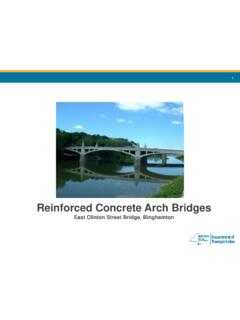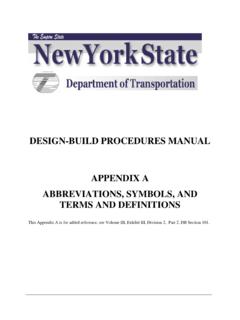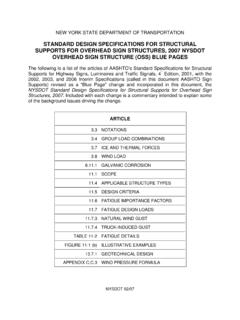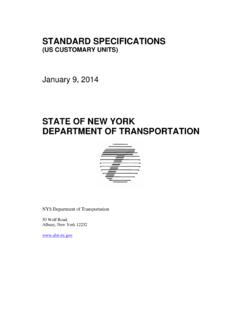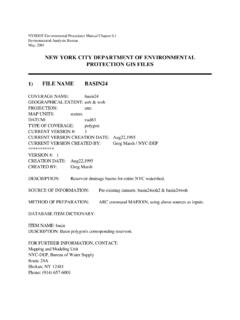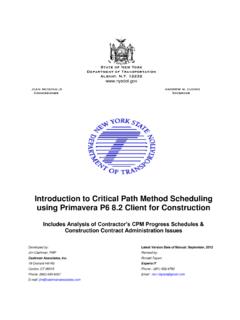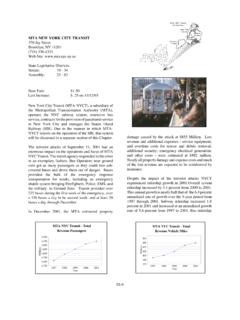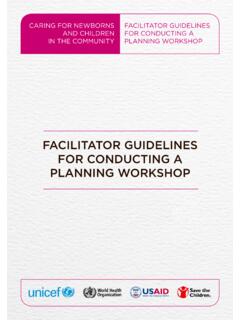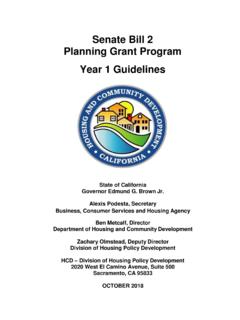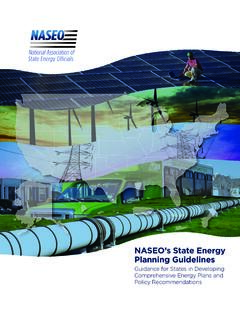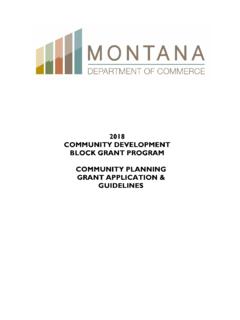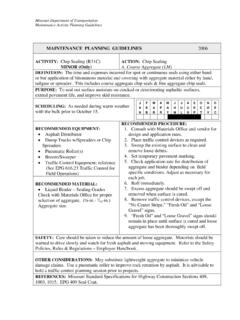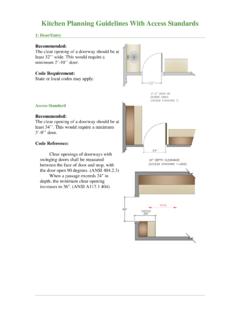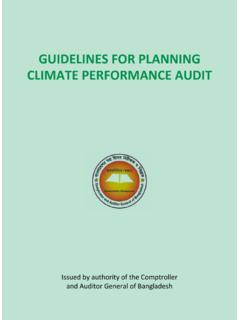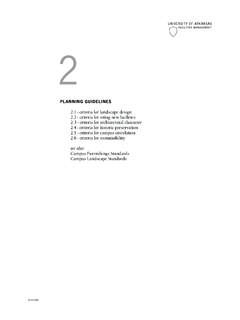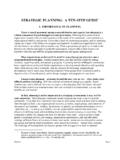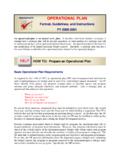Transcription of Amtrak Station Program and Planning Guidelines
1 AmtrakStation Program and Planning Guidelines6. Site 55 Introduction Multi-modal Planning Context Station /Platform Confi gurations Track and Platform Planning Vehicular Circulation Bicycle Parking Parking Amtrak Functional Requirements Information Systems and Way Finding Safety and Security Sustainable Design Universal Design 727. Station Introduction Architectural Overview Information Systems and Way Finding Passenger Information Display System (PIDS) Safety and Security Sustainable Design Accessibility 808. Platform Introduction Platform Types Platform-Track Relationships Connection to the Station Platform Length Platform Width Platform Height Additional Dimensions and Clearances Safety and Security Accessibility Snow Melting Systems 93 Appendix A. Contact List and Resources Contact List Additional Support Great American Stations Project Amtrak Manuals and Guidelines External Resources 95 Appendix B.
2 Parking 96 Appendix C. Station Waiting Room Capacity 97 Appendix D. Ticketing 99 Appendix E. Retail Areas 104 Appendix F. Interior Finishes and Fixtures 105 Appendix G. Mechanical Systems 1071. Overview Background Introduction Contents of the Guidelines Philosophy, Goals and Objectives Governing Principles 82. Process Introduction Stakeholder Coordination Concept Development Funding Real Estate Transactional Documents Basis of Design Construction Documents Project Delivery methods Commissioning Station Opening 183. Amtrak System Introduction Service Types Equipment Operations 264. Station Categories Introduction Summary of Characteristics Location and Geography Category 1 Large stations Category 2 Medium Stations Category 3 Caretaker Stations Category 4 Shelter Stations Thruway Bus Service 345. Program Introduction Program Components by Station Category Station Classifi cation and Features Matrix Public Entrance and Circulation Waiting and Boarding Waiting and Boarding Sequences Waiting Area Capacity Amtrak Customer Service Overview Ticket Offi ce Quik-Trak Ticket Offi ce Space Requirements Baggage Operation Overview Amtrak Support Spaces Overview Baggage Handling Baggage Claim Equipment and Storage Multi-modal Transit Services Station Amenities: Restrooms Station Amenities: Retail and Food Services Station Amenities: Other 54 Appendix H.
3 Electrical 109 Appendix I. Information Systems 113 Appendix J. Vertical Circulation Elements 121 Appendix K. Space Requirements 122 Appendix L. Prototype Stations 125 Appendix M. Historic Stations 129 Appendix N. Transit Art programs 131 Appendix O. LEED, Sustainability and Environmental References 133 Appendix P. Funding Sources 135 Appendix Q. Reference Documents 140 Appendix R. Glossary and Acronyms 141 Amtrak Station Program and Planning Guide1. Overview 5/1/20134 Copyright 2013 BackgroundAmtrak operates hundreds of intercity passenger trains every day, serving over 500 rail stations in 46 states and 3 Canadian provinces. Most Amtrak trains operate over track owned by freight railroads, and most of the stations served are owned by parties other than Amtrak , including commuter rail agencies, state and local governments, and private rail stations range from platform-only stations to large urban mixed-use transit centers; in addition, Amtrak serves over 300 bus stop locations with coordinated service.
4 This document is focused on rail stations but can also be used for bus facilities, where applicable. Each rail Station has unique design requirements, depending on whether it serves long-distance trains, state corridor service, or High Speed Rail (HSR), or more than one of the service types. Passenger waiting areas, ticket offi ces, baggage handling space, amenity spaces, and other functional aspects of the Station and platform are described in this is witnessing an exciting period in its history with many changes currently underway, including: Rapidly growing passenger ridership and growing state corridor service; Changes in rail operation, with new customer service offerings and procedures such as methods of ticketing and baggage handling; Planned growth in High Speed Rail (HSR) in many areas of the country, often in parallel to state corridor routes; Procurement of hundreds of new cars and locomotives; Refi nements to train and platform accessibility standards; Substantially expanded Station and platform accessibility.
5 And Changes in security standards and IntroductionThese Guidelines are intended to assist local governments, transportation agencies and authorities, designers, Amtrak staff and other stakeholders in the Planning , design, construction, rehabilitation, and redevelopment of Amtrak served passenger stations and related facilities. The Guidelines presented here establish design standards and criteria for stations, platforms, and the Station site, starting with governing principles, followed by information on the Planning and design process, service and facility types, Program requirements, Station features and amenities, Station fi nishes and architectural design. This document is intended to be used in concert with, and is complemented by, the Amtrak Engineering Stations Standard Design Practices (SDP), which provide further technical requirements, the Amtrak Graphic Standards Signage Manual and other resource documents listed in Appendix A .This document relies, in part, upon the categorization of stations based primarily on passenger volume.
6 Four levels of stations are defi ned:Category 1: Large Stations, fully staffed, with multiple transit services and amenities;Category 2: Medium Stations, lower levels of staff, and with some supporting transit and amenities;Category 3: Caretaker Stations, enclosed waiting spaces but no ticket agents and only limited amenities; andCategory 4: Unstaffed Stations, platforms with only shelters and/or canopies, and no amenitiesNote that these Guidelines are subject to periodic revision due to regulatory changes, changes in Amtrak policy, and other factors. When using these Guidelines , please verify that the version being used is the latest available, based on version number and date of issue. The latest version of the manual is available for download on the Great American Stations web site: is important to recognize that use of these Guidelines does not ensure Amtrak approval and/or agreement regarding any proposed Station improvements, and does not eliminate the need for coordination with Amtrak during all phases of Station design and Introduction1.
7 OverviewAmtrak Station Program and Planning Guide 5/1/20135 Copyright 2013 Contents of the GuidelinesThese Station Design Guidelines are organized to generally follow the sequence of the design and development process, beginning with general Planning and background information in the fi rst chapters, and proceeding to more detailed and technical information in the later chapters and appendices. The contents are organized as follows:Chapter 1: Overview - Introduces the Guidelines content and organization, and describes the Amtrak philosophy, goals, and objectives underpinning 2: Process - Discusses the Amtrak Station Planning and design process, including a description of the typical stakeholders with interests in the Station , and fi nancial and funding 3: Amtrak System - Describes the types of passenger service and related equipment that serve Amtrak 4: Station Categories - Describes the four Amtrak -defi ned Station facility types, ranging from large staffed stations to unstaffed shelters and adjacent platforms, based on annual ridership thresholds and level of staffi 5: Program - Describes the Amtrak Station Program components.
8 Includes space and function components, relationships between components and circulation 6: Site - Discusses multi-modal and transit oriented development, parking, sustainability, and design and 7: Station - Includes guidance for all Station design issues, including space programming, functional relationships, circulation elements and materials and fi 8: Platform - Includes guidance for the platforms and - The appendices included at the end of these Guidelines document contain supplementary materials to assist in the design process, and are referenced in the text of the individual chapters described of the GuidelinesAmtrak Station Program and Planning Guide1. Overview 5/1/20136 Copyright 2013 Philosophy, Goals and ObjectivesPhilosophy the Seamless JourneyAmtrak has adopted a goal of becoming a safer, greener, healthier passenger railroad, and to further this goal, these Guidelines establish a number of performance metrics for Station improvements: Passenger experience: Station quality, services, and amenities, as part of the seamless journey ; Quality design and architecture integration of all design elements; Community asset: intermodal, mixed-use facilities; Operational effi ciency; Flexible facilities; Safety and security; Sustainable buildings and operations; Universal design and accessibility.
9 And Regulatory Station Program and Planning Guide has been developed to support the improvement and maintenance of these performance further the goal of delivering quality intercity passenger rail service, Amtrak has developed a philosophy of the Seamless Journey that comprises ten components of the travel experience as shown in the illustration below. The term Seamless Journey refers to the concept of providing service to Amtrak customers from the beginning to the end of the passenger trip. It includes delivering needed information at all points of the trip-making process; supporting simplifi ed decision-making and choices; and providing an appealing, safe, comfortable and quality experience throughout the trip. The Station must fi rst and foremost serve the passenger, providing safety, comfort, expediency, and enjoyment of the travel experience. Note that most of the ten steps in the seamless journey take place in a Station .:NK 9 KGSRKYY 0U[XTK_1.]
10 LEARNINGpre-contactawareness2. Planning reservations, itinerariesand transactions3. STARTING getting to the station4. ENTERING arriving at the station5. TICKETING purchasing and issuing transactions6. WAITING conventional lounge and retail7. BOARDING moving to the platform and entering the train9. ARRIVING leaving the train and re-entry to station8. RIDING premium and standard offerings10. CONTINUING from concourse to beyondPhilosophy, Goals, and ObjectivesThe Seamless Journey1. OverviewAmtrak Station Program and Planning Guide 5/1/20137 Copyright 2013 Quality Passenger and Visitor ExperienceAs the Seamless Journey philosophy suggests, the Amtrak passenger experience is multi-dimensional and several parts of the journey take place at the Station . Even a visitor, entering a Station to buy a ticket, drop off a passenger, or obtain information, experiences multiple facets of the Seamless Journey. Because the Station represents a major portion of the travel experience, it is imperative to create an environment in the Station that is welcoming, functional, and clean one that will be memorable and will encourage repeat business for Amtrak and create a civic focal point in the Good Service From ticketing to waiting, to boarding, to riding, the passenger experiences courteous and effi cient service; and Station operations, back offi ce support and baggage handling are performed with effi ciency and sustainability in Convenient Access to the Station Station is a major hub in a multimodal network connecting downtown and other important places in the Enjoyable physical environment in and around the Station The passenger or visitor experiences the Station as a community asset or important public place; Through its urban design and architectural design, the Station positively contributes to the public realm.
